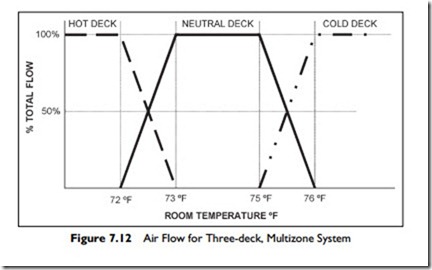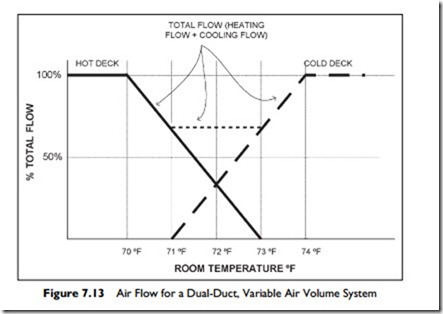Dual-Duct, Variable Air Volume Systems
The dual-duct, variable air volume (VAV) system provides the thermal efficiency of the VAV system while generally maintaining higher air flows, and thus better circulation of air in the room, when heating is required. The difference is that the air is not drawn into the building by a constant volume fan, as it is in the usual dual-duct system, but it is split into two air streams that flow through two variable-volume fans. One air stream passes through
a heating coil and one through a cooling coil. The two air streams are then ducted throughout the building.
The mixing of these two air streams is carried out in a mixing box serving each thermal zone. These mixing boxes can vary both the proportions of hot and cold air, and also the total flow rate of air to the zone. This is in contrast to the more conventional dual-duct system where the airflow delivered by the mixing box is constant.
The variation of flow in the dual-duct, variable-air-volume system is shown in Figure 7.13. This diagram indicates equal volume flows for both heating air and cooling air. Depending on the climate and resulting loads, the heating flow many be 50% less than the cooling airflow, but the control logic is the same. At maxi- mum cooling load, the box provides sufficient cold air to meet the load. As the cooling load decreases, the volume of cold air is decreased, without addition of hot air to change the temperature. When the cooling load reaches the point where the cold airflow equals the minimum allowable flow, the cold flow continues to decrease, but the hot air is added to maintain sufficient total flow. As the heating load increases, the total flow remains constant while its temperature is increased above room temperature by increasing the proportion of air from the hot deck. When the cold deck flow reaches zero, the temperature of the delivered air will be the hot deck temperature. As the heating load increases further, the requirement for more heat is satisfied by increasing the volume flow-rate of hot air.

